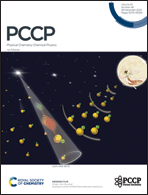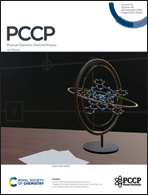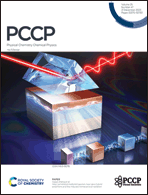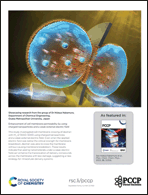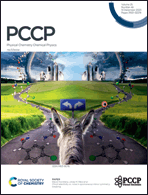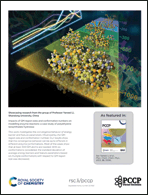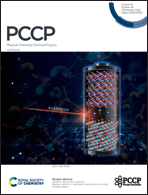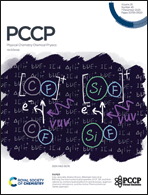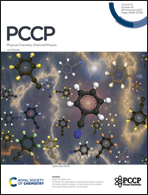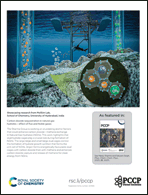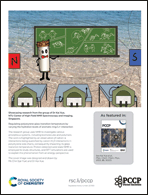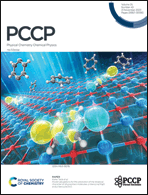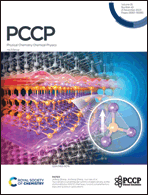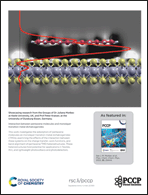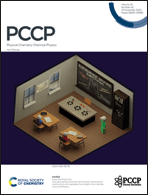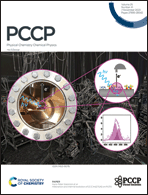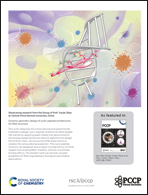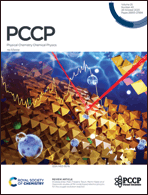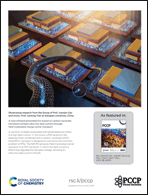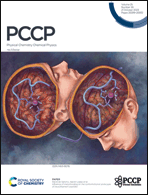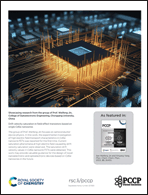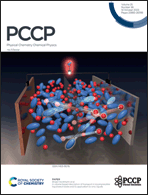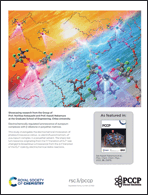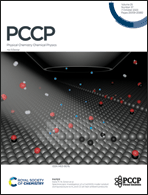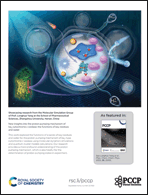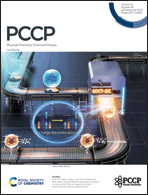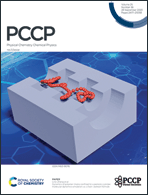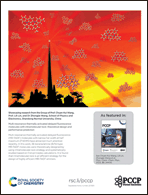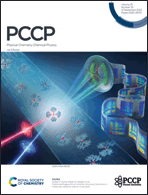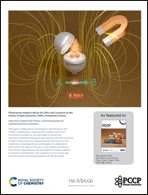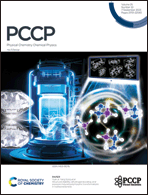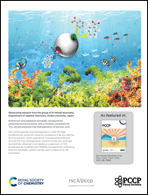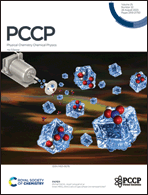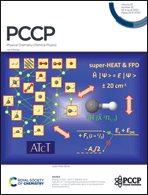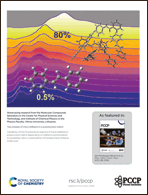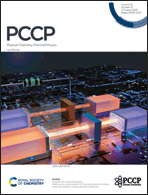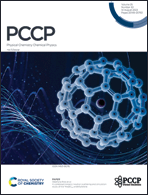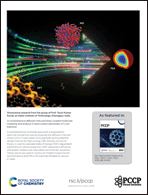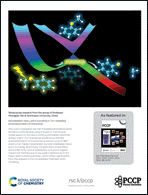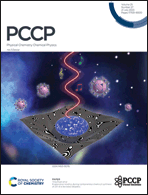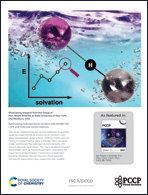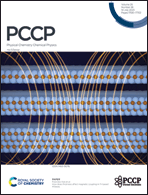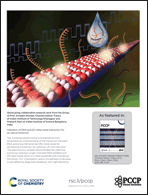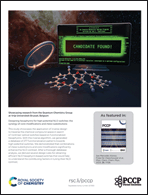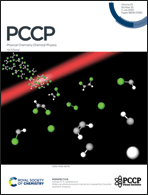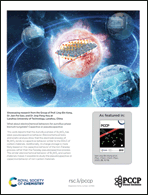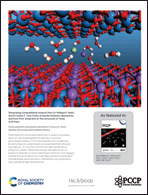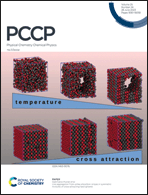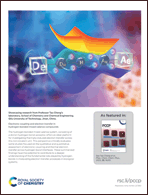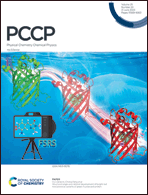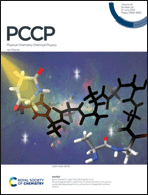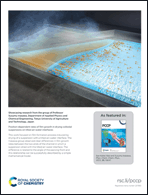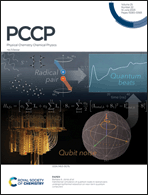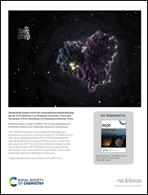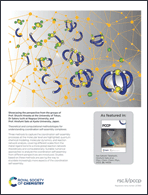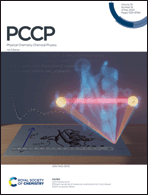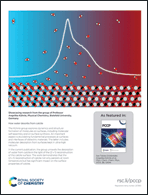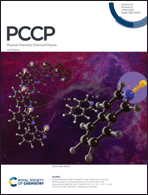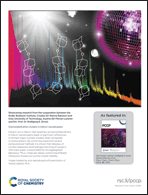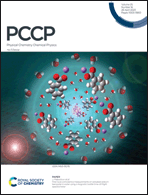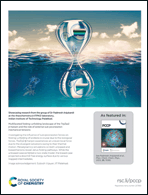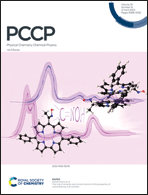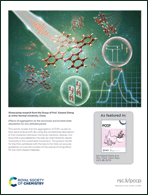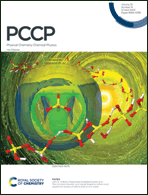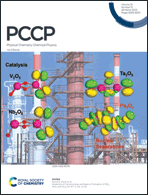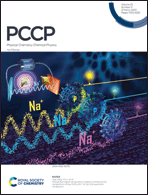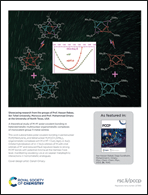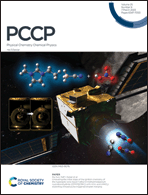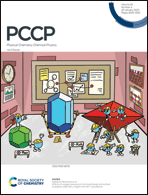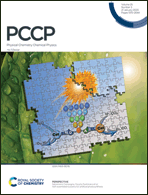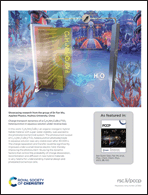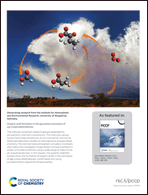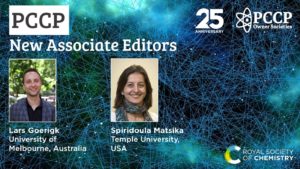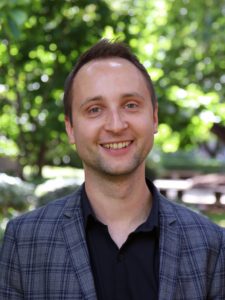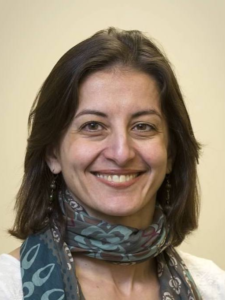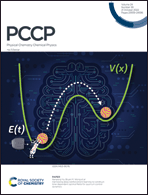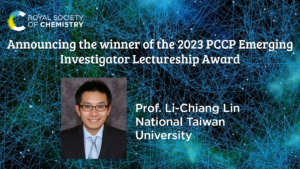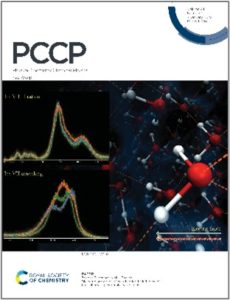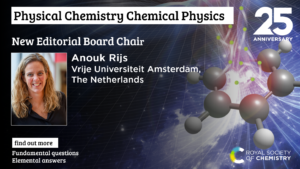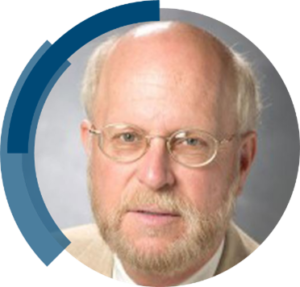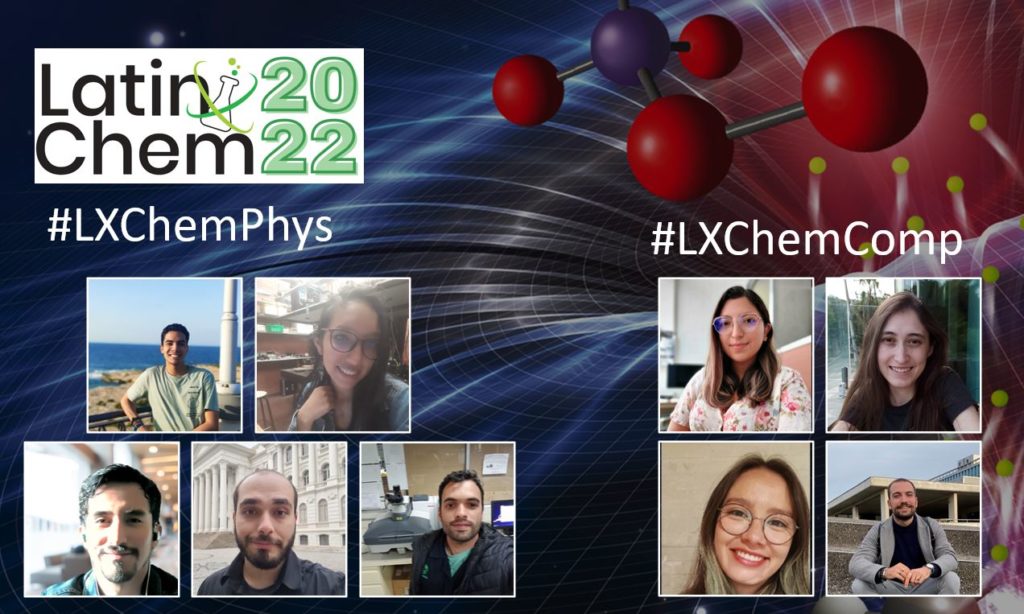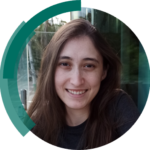 |
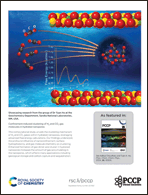 |
||
| Predicting two-dimensional semiconductors using conductivity effective mass
Wenjun Zhang, Zhikun Yao and Lee A. Burton Phys. Chem. Chem. Phys., 2024, 26, 10520 DOI:10.1039/D4CP00277F |
Confinement-induced clustering of H2 and CO2 gas molecules in hydrated nanopores
Aditya Choudhary and Tuan A. Ho Phys. Chem. Chem. Phys., 2024, 26, 10506 DOI:10.1039/D3CP06024A |
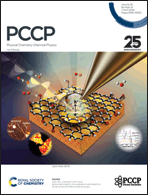 |
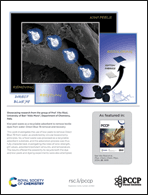 |
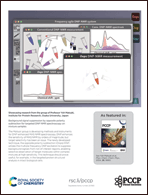 |
|
| Nanoscale insights into graphene oxide reduction by tip-enhanced Raman spectroscopy
Xiao You, Sangita Maharjan, Kizhanipuram Vinodgopal and Joanna M. Atkin Phys. Chem. Chem. Phys., 2024, 26, 9871 DOI:10.1039/D3CP04711C |
Kiwi peel waste as a recyclable adsorbent to remove textile dyes from water: Direct Blue 78 removal and recovery
Jennifer Gubitosa, Vito Rizzi, Paola Fini, Sergio Nuzzo and Pinalysa Cosma Phys. Chem. Chem. Phys., 2024, 26, 9891 DOI:10.1039/D4CP00174E |
Background signal suppression by opposite polarity subtraction for targeted DNP NMR spectroscopy on mixture samples
Zhongliang Zhang, Ken Kato, Hajime Tamaki and Yoh Matsuki Phys. Chem. Chem. Phys., 2024, 26, 9880 DOI:10.1039/D3CP06280E |
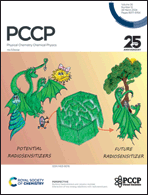 |
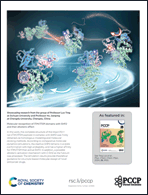 |
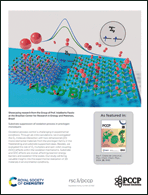 |
|
| Interaction of low-energy electrons with radiosensitizers
Barbora Sedmidubská and Jaroslav Kočišek Phys. Chem. Chem. Phys., 2024, 26, 9112 DOI:10.1039/D3CP06003A |
Molecular recognition of ITIM/ITSM domains with SHP2 and their allosteric effect
Yan Cheng, Weiwei Ouyang, Ling Liu, Lingkai Tang, Zhigang Zhang, Xinru Yue, Li Liang, Jianping Hu and Ting Luo Phys. Chem. Chem. Phys., 2024, 26, 9155 DOI:10.1039/D3CP03923D |
Substrate suppression of oxidation process in pnictogen monolayers
Rafael L. H. Freire, F. Crasto de Lima and A. Fazzio Phys. Chem. Chem. Phys., 2024, 26, 9149 DOI:10.1039/D3CP03976E |
 |
 |
||
| Electron doping as a handle to increase the Curie temperature in ferrimagnetic Mn3Si2X6 (X = Se, Te)
Lei Qiao, Paolo Barone, Baishun Yang, Phil D.C. King, Wei Ren and Silvia Picozzi Phys. Chem. Chem. Phys., 2024, 26, 8604 DOI:10.1039/D3CP05525F |
A density functional theory benchmark on antioxidant-related properties of polyphenols
Rodrigo A. Mendes, Victor A. S. da Mata, Alex Brown and Gabriel L. C. de Souza Phys. Chem. Chem. Phys., 2024, 26, 8613 DOI:10.1039/D3CP04412B |
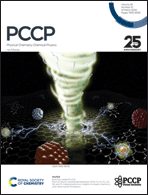 |
 |
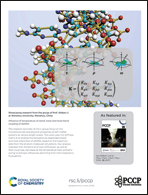 |
|
| Electron beam-induced demetallation of Fe, Co, Ni, Cu, Zn, Pd, and Pt metalloporphyrins: insights in e-beam chemistry and metal cluster formations
Jongseong Park, Sol Lee, Orein Francis Jafter, Jinwoo Cheon and Dominik Lungerich Phys. Chem. Chem. Phys., 2024, 26, 8051 DOI:10.1039/D3CP05848D |
Poly(dimethylsiloxane) as a room-temperature solid solvent for photophysics and photochemistry
John A. Clark, Samantha Robinson, Eli M. Espinoza, Duoduo Bao, James B. Derr, Luca Croft, Omar O’Mari, William H. Grover and Valentine I. Vullev Phys. Chem. Chem. Phys., 2024, 26, 8062 DOI:10.1039/D3CP05413F |
Influence of temperature on bend, twist and twist–bend coupling of dsDNA
Zihao Zhang, Xuankang Mou, Yahong Zhang, Linli He and Shiben Li Phys. Chem. Chem. Phys., 2024, 26, 8077 DOI:10.1039/D3CP04932A |
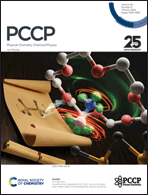 |
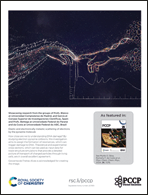 |
||
| A confinement-regulated (H3C–NH3)+ ion as a smallest dual-wheel rotator showing bisected rotation dynamics
Wang Li, Miao Xie, Shi-Yong Zhang, Cheng-Hui Zeng, Zi-Yi Du and Chun-Ting He Phys. Chem. Chem. Phys., 2024, 26, 7269 DOI:10.1039/D3CP05406C |
Elastic and electronically inelastic scattering of electrons by the pyrazine molecule
Murilo O. Silva, Giseli M. Moreira, Jaime Rosado, Francisco Blanco, Gustavo García, Márcio H. F. Bettega and Romarly F. da Costa Phys. Chem. Chem. Phys., 2024, 26, 7276 DOI:10.1039/D3CP04619B |
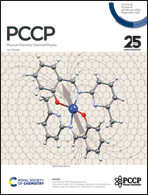 |
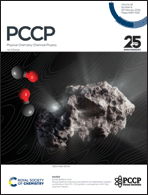 |
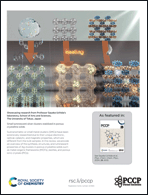 |
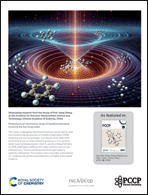 |
| Tetracoordinate Co(II) complexes with semi-coordination as stable single-ion magnets for deposition on graphene
Jorge Navarro Giraldo, Jakub Hrubý, Šárka Vavrečková, Ondřej F. Fellner, Lubomír Havlíček, DaVonne Henry, Shehan de Silva, Radovan Herchel, Miroslav Bartoš, Ivan Šalitroš, Vinicius T. Santana, Paola Barbara, Ivan Nemec and Petr Neugebauer Phys. Chem. Chem. Phys., 2023, 25, 29516 DOI:10.1039/D3CP01426F |
Mixed quantum/classical calculations of rotationally inelastic scattering in the CO + CO system: a comparison with fully quantum results
Dulat Bostan, Bikramaditya Mandal, Carolin Joy, Michał Żółtowski, François Lique, Jérôme Loreau, Ernesto Quintas-Sánchez, Adrian Batista-Planas, Richard Dawes and Dmitri Babikov Phys. Chem. Chem. Phys., 2024, 26, 6627 DOI:10.1039/D3CP05369E |
Small luminescent silver clusters stabilized in porous crystalline solids
Naoya Haraguchi, Taisei Kurosaki and Sayaka Uchida Phys. Chem. Chem. Phys., 2024, 26, 6512 DOI:10.1039/D3CP04589G |
Photochemical mechanistic study of hexafluorobenzene involving the low-lying states
Duoduo Li, Xinli Song, Jinming Liu and Song Zhang Phys. Chem. Chem. Phys., 2024, 26, 6638 DOI:10.1039/D3CP04184K |
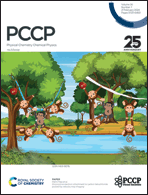 |
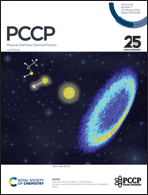 |
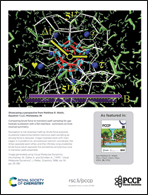 |
|
| Dissociative electron attachment to carbon tetrachloride probed by velocity map imaging
Anirban Paul, Dhananjay Nandi, Daniel S. Slaughter, Juraj Fedor and Pamir Nag Phys. Chem. Chem. Phys., 2024, 26, 5783 DOI:10.1039/D3CP04834A |
Dynamics of dissociative electron attachment to aliphatic thiols
Sukanta Das and Vaibhav S. Prabhudesai Phys. Chem. Chem. Phys., 2024, 26, 5793 DOI:10.1039/D3CP05456J |
Comparing brute force to transition path sampling for gas hydrate nucleation with a flat interface: comments on time reversal symmetry
Matthew R. Walsh Phys. Chem. Chem. Phys., 2024, 26, 5762 DOI:10.1039/D3CP05059A |
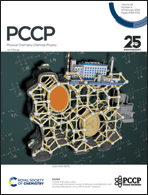 |
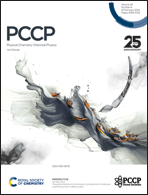 |
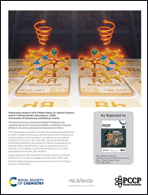 |
|
| A thorough mechanistic study of ethanol, acetaldehyde, and ethylene adsorption on Cu-MOR via DFT analysis
Yuli Ma and Junyu Lang Phys. Chem. Chem. Phys., 2024, 26, 4845 DOI:10.1039/D3CP05314H |
Theoretical trends in the dynamics simulations of molecular machines across multiple scales
Weijia Xu, Yuanda Tao, Haoyang Xu and Jin Wen Phys. Chem. Chem. Phys., 2024, 26, 4828 DOI:10.1039/D3CP05201J |
Chiroptical activity of benzannulated N-heterocyclic carbene rhenium(I) tricarbonyl halide complexes: towards efficient circularly polarized luminescence emitters
Valerio Giuso, Christophe Gourlaouen, Mathias Delporte–Pébay, Thomas Groizard, Nicolas Vanthuyne, Jeanne Crassous, Chantal Daniel and Matteo Mauro Phys. Chem. Chem. Phys., 2024, 26, 4855 DOI:10.1039/D3CP04300B |
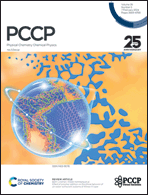 |
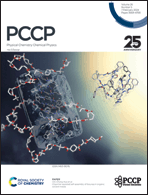 |
 |
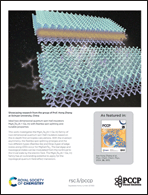 |
| Effect of polymer addition on the phase behavior of oil–water–surfactant systems of Winsor III type
Ming Lu, Björn Lindman and Krister Holmberg Phys. Chem. Chem. Phys., 2024, 26, 3699 DOI:10.1039/D3CP04730J |
Oligomer-assisted self-assembly of bisurea in organic solvent media
Ching-Hung Wu, Ling-Hua Huang and Chi-Chung Hua Phys. Chem. Chem. Phys., 2024, 26, 3810 DOI:10.1039/D3CP04464E |
Unexpected reduction in thermal conductivity observed in graphene/h-BN heterostructures
Zhang Wu, Rumeng Liu, Ning Wei and Lifeng Wang Phys. Chem. Chem. Phys., 2024, 26, 3823 DOI:10.1039/D3CP05407A |
Ideal two-dimensional quantum spin Hall insulators MgA2Te4 (A = Ga, In) with Rashba spin splitting and tunable properties
Jiaqi Li, Xinlu Cheng and Hong Zhang Phys. Chem. Chem. Phys., 2024, 26, 3815 DOI:10.1039/D3CP04898E |
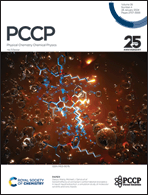 |
 |
 |
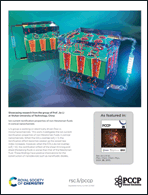 |
| Solvent effects on extractant conformational energetics in liquid–liquid extraction: a simulation study of molecular solvents and ionic liquids
Xiaoyu Wang, Srikanth Nayak, Richard E. Wilson, L. Soderholm and Michael J. Servis Phys. Chem. Chem. Phys., 2024, 26, 2877 DOI:10.1039/D3CP04680J |
Experimental phase diagram and its temporal evolution for submicron 2-methylglutaric acid and ammonium sulfate aerosol particles
Qishen Huang, Kiran R. Pitta, Kayla Constantini, Emily-Jean E. Ott, Andreas Zuend and Miriam Arak Freedman Phys. Chem. Chem. Phys., 2024, 26, 2887 DOI:10.1039/D3CP04411D |
An OrthoBoXY-method for various alternative box geometries
Johanna Busch and Dietmar Paschek Phys. Chem. Chem. Phys., 2024, 26, 2907 DOI:10.1039/D3CP04916G |
Ion current rectification properties of non-Newtonian fluids in conical nanochannels
Lei Tang, Yu Hao, Li Peng, Runxin Liu, Yi Zhou and Jie Li Phys. Chem. Chem. Phys., 2024, 26, 2895 DOI:10.1039/D3CP05184F |
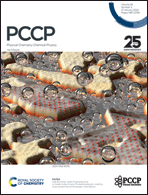 |
 |
 |
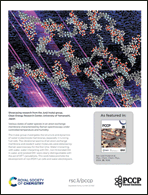 |
| A model study of ceria–Pt electrocatalysts: stability, redox properties and hydrogen intercalation
Lukáš Fusek, Pankaj Kumar Samal, Jiří Keresteš, Ivan Khalakhan, Viktor Johánek, Yaroslava Lykhach, Jörg Libuda, Olaf Brummel and Josef Mysliveček Phys. Chem. Chem. Phys., 2024, 26, 1630 DOI:10.1039/D3CP03831A |
Addressing electronic and dynamical evolution of molecules and molecular clusters: DFTB simulations of energy relaxation in polycyclic aromatic hydrocarbons
Mathias Rapacioli, Maysa Yusef Buey and Fernand Spiegelman Phys. Chem. Chem. Phys., 2024, 26, 1499 DOI:10.1039/D3CP02852F |
Analysis and interpretation of first passage time distributions featuring rare events
Esmae J. Woods and David J. Wales Phys. Chem. Chem. Phys., 2024, 26, 1640 DOI:10.1039/D3CP04199A |
Various states of water species in an anion exchange membrane characterized by Raman spectroscopy under controlled temperature and humidity
Solomon Wekesa Wakolo, Donald A. Tryk, Hiromichi Nishiyama, Kenji Miyatake, Akihiro Iiyama and Junji Inukai Phys. Chem. Chem. Phys., 2024, 26, 1658 DOI:10.1039/D3CP03660J |
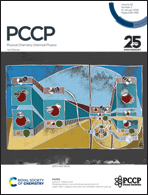 |
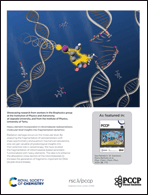 |
 |
|
| Modeling Henry’s law and phase separations of water–NaCl–organic mixtures with solvation and ion-pairing
Aaron D. Wilson, Zi Hao Foo, Ashini S. Jayasinghe, Caleb Stetson, Hyeonseok Lee, Harry W. Rollins, Akshay Deshmukh and John H. Lienhard Phys. Chem. Chem. Phys., 2024, 26, 749 DOI:10.1039/D3CP02003G |
Heavy element incorporation in nitroimidazole radiosensitizers: molecular-level insights into fragmentation dynamics
Pamela H. W. Svensson, Lucas Schwob, Oscar Grånäs, Isaak Unger, Olle Björneholm, Nicusor Timneanu, Rebecka Lindblad, Anna-Lydia Vieli, Vicente Zamudio-Bayer, Martin Timm, Konstantin Hirsch, Carl Caleman and Marta Berholts Phys. Chem. Chem. Phys., 2024, 26, 770 DOI:10.1039/D3CP03800A |
Bacterial model membranes under the harsh subsurface conditions of Mars
Attila Tortorella, Rosario Oliva, Concetta Giancola, Luigi Petraccone and Roland Winter Phys. Chem. Chem. Phys., 2024, 26, 760 DOI:10.1039/D3CP03911K |
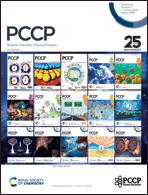 |
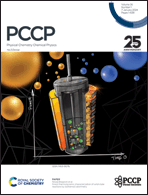 |
 |
 |
| The 25th Anniversary celebratory cover of PCCP
|
Direct thermodynamic characterization of solid-state reactions by isothermal calorimetry
Marija Cvetnić, Robert Šplajt, Edi Topić, Mirta Rubčić and Nikola Bregović Phys. Chem. Chem. Phys., 2024, 26, 67 DOI:10.1039/D3CP03933A |
Enhancing the upconversion of Er3+ incorporated BaTiO3 by introducing oxygen vacancies
Young Gwon Jung, Hyeongyu Bae and Kang Taek Lee Phys. Chem. Chem. Phys., 2024, 26, 76 DOI:10.1039/D3CP02133E |
Overcoming the barrier: designing novel thermally robust shape memory vitrimers by establishing a new machine learning framework
Cheng Yan, Xiaming Feng, John Konlan, Patrick Mensah and Guoqiang Li Phys. Chem. Chem. Phys., 2023, 25, 30049 DOI: 10.1039/D3CP03631F |











